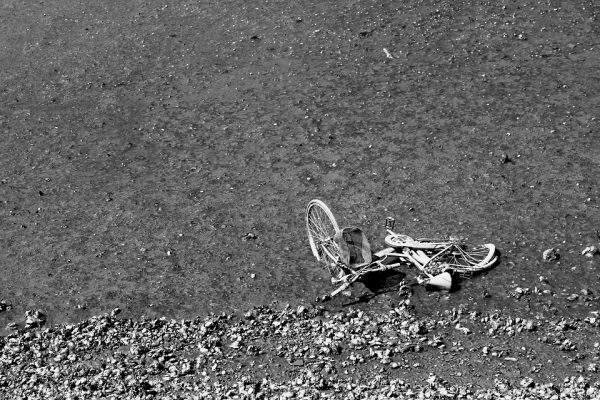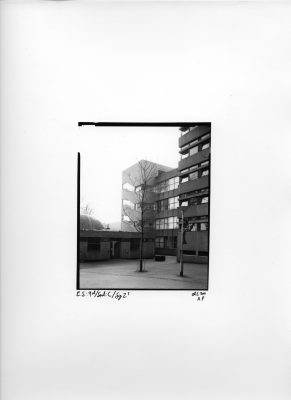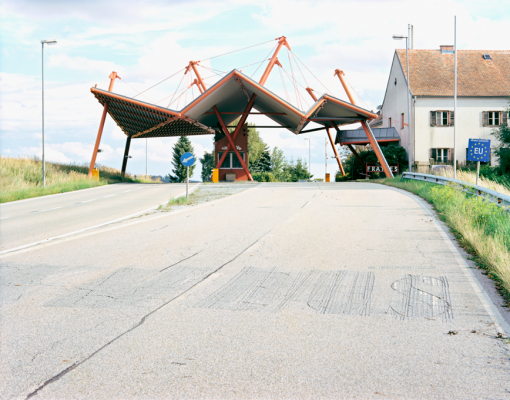No terrain is impossible for the Urban Cyclist. His powerful legs drive the pedals down in alternation, right, left, right, left, calculating the degree of incline by the strength required of his thigh and calf muscles for each complete revolution of the front sprocket. The soles of his feet and palms of his hands read each vibration transferred from the tyres to the handlebars and frame, making micro-adjustments to his direction and balance at a speed faster than thought. The initial uphill stretch when he first leaves the house is short and serves to lubricate his joints and warm up his muscles. He quickly reaches Reservation Street. Its sloping cobbled lanes are separated by a grassy central reservation. Five blocks to The Strip. Knowing every inch of the way like the back of his hand doesn’t make the challenge any less dangerous for the Urban Cyclist. From one week to the next, so much can change. A resident might decide to have a new driveway put in so they can park their car in the garage more comfortably, and may have to deposit mounds of sand, gravel and cement in the middle of the pavement, an example of the kind of mutant obstacle for which the true Urban Cyclist must be prepared. There are dogs that shoot out like rockets from behind walls to try to snaffle a bit of their favourite food, an unwary cyclist’s shin. Even trees, an apparently peaceful and inoffensive element of the natural world, from one week to the next push out branches and roots, which can obstruct the Cyclist’s path. Weeds sprout from the pavement, concealing pebbles, holes and bricks that can catch one by surprise and cause serious accidents from which only the most skilled, experienced cyclists emerge unscathed.
The day is auspicious for a high-risk, high-speed ride. It’s chilly out, with a cold wind of medium intensity and a clear sky. Although the wind causes certain discomfort, whipping the Cyclist’s face and making breathing difficult, it means he perspires less, thus reducing the need to wipe sweat from his eyes and the risk of his hand slipping on the bike’s plastic grips, an accident whose price would be nothing less than a few broken teeth and ribs.
On Reservation Street, he slows almost to a complete halt and gazes for a few seconds at the five-block slope stretching down before him like the throat of a giant pachyderm. Balancing like this without touching the ground requires excellent technique from the rider and perfect synchronicity between cyclist and bike, a synchronicity which the Urban Cyclist most definitely shares with his old-fashioned-but-fierce, white-framed, blue-stickered 20-inch Caloi Cross BMX, with a foot brake and red balloon tyres with a grooved tread in the place of the slim black originals, which were unsuited to the speed and terrain of elite urban cycling.
After a few seconds analysing his course, which includes checking for traffic coming up or down the street, pedestrians or animals on the pavement, moisture in the terrain, the thrust of the wind and the chance of rain, among other things, and already confident, after careful inspection back in his garage, that the bike is in a perfect state of maintenance, including wheel alignment, spoke adjustment, brake function and air pressure in tyres, as well as chain, bearing and sprocket lubrication (a few drops of Singer oil on the main articulated parts are essential), the Urban Cyclist launches himself downhill, pedalling at such a breakneck speed that any observer would be dumbfounded.
With a few quick turns of the pedals, he attains a speed at which the vibration of the wheels on the cobblestones is almost too much to bear. But the Cyclist is familiar with this stretch and knows he must hold his wrists firm for a few more seconds until, with a sharp manoeuvre to the left that would seem like madness to your average cyclist, he jumps over the central reservation, taking advantage of a kerb cut, crosses the oncoming lane, shoots diagonally up a driveway to the pavement and deftly executes a quick right-hand swerve with the handlebars just in time to avoid colliding head-on with an unfinished cement wall whose surface looks as though bits of human skin and flesh would adhere to it nicely. This is the first of five tricky spots in today’s course, assuming, that is, that there are no surprises. Now on the pavement, the Cyclist passes five houses without many bumps or changes in the terrain, and allows himself to relax for a few seconds, reposition his hands on the grips, release the tension in his knees and elbows, and quickly take in the view until his gaze finds the waters of the Guaíba in the distance, dotted with white sails. On his right, now, are houses built within the last year, several with still-immaculate paint and roof tiles, separated from one another by mini-forests. On his left, the land is predominantly arid with long eroded strips of hard, orange dirt that extend down to the foot of the hill and give way to a flat area where extremely straight streets demarcate rectangular blocks divided into plots of land for sale. The subdivision of Porto Alegre’s southern suburbs is new, and few, to date, have taken up residence there. The Cyclist is a pioneer intent on mapping every inch of this inhospitable zone with his fearless wheels. An intersection. His ears quickly sweep the surroundings for noises that might indicate the potential threat of motor vehicles. Negative. Only the repetitive chirping of birds. A jump from kerb to street, vibration. He returns to the kerb with a wheelie, swerves around the stump of a sawn-off tree that is still oozing bubbly resin and comes to the second tricky spot, a sequence of three adjacent driveways whose ramps form a series of stairs. The Cyclist pedals backwards, applying light pressure to the brakes, vaulting from one level to the next at precisely the right speed. Jump, jump, jump. Sweat is already streaming in salty beads from his temples and pooling above his upper lip. The sandstone pavement suddenly disappears and gives way to a patch of brush that conceals a tangle of tree roots. This is the third tricky spot, perhaps the most dangerous of all, because the roots are hidden and no matter how many times he’s ridden it it’s impossible to memorise them all. Here the Urban Cyclist recognises that his planning counts for nothing. The terrain calls the shots and decides if you are going to fall or not; all he can do is steady his wrists and be careful to relax his arm and leg joints so that they can act as natural shock-absorbers, leaving enough slack for the bike to transfer the impact to his muscles. The most important thing is for rider and bike to maintain their balance as they cross the grass studded with traps of live wood, which may also contain a cruel shard of glass, a rusty tin can or a dead opossum. When he gets to the end of the pavement, everything is still under control. He jumps over the kerb again but doesn’t return to the pavement, as he knows he will soon come to a long stretch of dense vegetation that is impossible to cross. An elite urban cyclist must above all master the art of simultaneously dividing his attention between the front wheel of his bike, the terrain directly in front of him, and whatever is coming up a few dozen yards off. To neglect to do so can be costly when traversing such wild, unpredictable terrain as this at such a high speed. He knew in advance, thanks to his powers of observation, that he wouldn’t return to the pavement at this point, and he continues down the middle of the street, bracing himself through a new stretch of intense vibration on the cobblestones until he reaches the end of Reservation Street and the fourth tricky spot, The Strip.
The Strip is a tarmacked avenue. His course only takes in fifty-odd yards of it, until he can take a right on Shade Street and follow it to his final objective, Guaíba Avenue. To an urban cyclist, fifty yards of docile, smooth tarmac should be a breeze. But when this stretch of tarmac has cars, buses, trucks and carts travelling along it in both directions, and you arrive at it from a perpendicular cobbled street at something like twenty-five miles an hour, or thirty-six feet a second, it becomes tricky spot number four. The Urban Cyclist requires a very light, stripped-back bike, like his 20-inch Caloi with the foot brake, for situations like this. He doesn’t wear a helmet, gloves, toe clips, or Lycra shorts that cling to his rear. That’s for girls. The Urban Cyclist wears ordinary trainers, shorts that allow plenty of air circulation, a short-sleeved T-shirt in summer and a long-sleeved one in winter. That’s it. A cap is allowed on rainy days or when it’s very sunny. As for the foot brake, the Cyclist knows it is scoffed at by most cyclists, who consider it old-fashioned, unsafe and hard to operate. It does take a great deal of training to really master the foot brake, it is true, but once you have the hang of it, you’ll never want to change to a modern braking system, with levers on the handlebars. The Urban Cyclist jams on his trusty foot brake with a backward turn of the pedal and goes into a skid across the cobblestones. The fine layer of sand and gravel covering the last few yards of the street influences the bike’s behaviour, reducing its traction to a negligible level. This has, of course, been taken into account by the Cyclist, who carries out a visual survey of the traffic on both lanes of The Strip and decides that he doesn’t need to brake fully. On the contrary, he skilfully accelerates out of the skid and crosses The Strip, watched by two women at a bus stop, who are shocked at his audacity. There isn’t time to show off. He picks up speed on the tarmac, eighteen, nineteen, twenty feet a second, and now makes a wide curve to the right, perfect and safe. Shade Street is even bumpier than Reservation Street. He has no choice but to take one of the pavements. The one on the right offers the most exciting ride. Although deeply focused, the Urban Cyclist savours his secret: the pavements of residential streets in big cities. Nobody else recognises them as the ultimate terrain for the practice of high-level radical stunt riding. He makes an S around two trees in close sequence, swerving first right, then left. In the foreground is the sound of his tyres on the different kinds of pavement, the wind in his ears, the metallic taste of speed. Only he knows this pleasure. He crosses another street and returns to the pavement of the next block. He can see Guaíba Avenue, skirting the vast expanse of brown water. This is the home stretch.
The bike becomes airborne. He has made a mistake. He forgot the fifth tricky spot: the slimy pavement, a permanently moist section beneath a roof of treetops that does justice to the nickname ‘Shade Street’ and is always covered in slime. Almost zero traction. Slippery as soap. The bike went into a skid and he thought about throwing himself to the ground, but there wasn’t time, because the front wheel hit the low retaining wall of a tiny flowerbed graced with a dozen pansies and camellias, and now he and the bike are sailing through the air, and now they are tumbling over the cobblestones of Shade Street, the Cyclist’s foot caught in the frame of his 20-inch Caloi with the foot brake, and they roll and slide together for several yards, leaving a wake of dust behind them.
The Urban Cyclist lies in the middle of the street for at least ten seconds, his leg still caught in the bike, while the neighbourhood dogs bark in a frenzy. When his brain starts working again, the first thing that occurs to him is that his face must be deformed. He runs his hand over it and finds a little blood on his thumb. His tongue registers the sour taste and what appears to be a small flap of loose skin on his lower lip. He frees his leg from the bike, the right one, and examines it. A small white circle under his knee begins to sprout minuscule red dots, which become drops of blood that swell and start to run down his leg. Parts of his body that were numb begin to sting. A tickle in his nose, a knot in his throat, and he can’t hold back the tears. They aren’t tears of pain or of fear, really, although he is afraid, afraid of his face being deformed, of having to have stitches at the emergency room, of lots of things, but he cries above all out of frustration. Just as mountains can grow angry and greet the most able and respected climber with an avalanche, this time the pavement has greeted him with a surface of slimy stones and he has been brought down by his opponent in a moment of distraction, a stupid moment of distraction. He has fallen.
He is no longer the Urban Cyclist. Now he is just a ten-year-old boy. But the street is quiet, there are no cars or people around. It is almost three o’clock on a Wednesday afternoon and everyone is busy with something, no one is out and about, much less on a remote residential street in the southern suburbs where people don’t have much reason to leave their houses except to go to work or to run errands downtown. He decides to get up and go and look for help, maybe call home from a public phone and reverse the charge. He has no difficulty standing up. He wipes the blood from his mouth again. He wishes he had a mirror now – more than anything, a mirror. He walks towards Guaíba Avenue, where there are bars and a phone booth and people jogging. He is fine until he glances down at his knee. Through the wound – a hole half an inch in diameter and of considerable depth for a surface as devoid of padding as a knee – the blood now runs freely down his shin, drenching his white cotton socks. Something isn’t right. His legs feel weak and his entire body is covered with a fine sweat, very different from the sweat worked up previously through physical effort.
He looks for something to lean on, but can’t find anything. The dizziness is too much. He falls to the ground, on the pavement. And what he sees beside him, crouching there, is a kitten. A mottled grey kitten tied with a length of blue string to a barbed-wire fence. The improvised collar is no more than six inches long. The kitten looks weak but, feeling threatened, it meows and shows its teeth. Woozy, the Cyclist lifts his head and sees a little old lady closing a wooden gate and walking towards him. Perhaps influenced by the kitten, his first reaction is fear, but then he realises that the old lady is his salvation, help. She leans over to console him.
‘That was quite a tumble, child. Don’t cry, don’t cry, let me see.’
Her voice is a little hoarse, but at the same time sweet and contrived like that of a children’s TV show hostess. Her hair is light brown, her face is criss-crossed with fine, shallow wrinkles, and she has no neck. Her head looks as if it has been screwed straight on to her body. She is wearing a long skirt, which must have been red and is now a faded pink, and a light-beige jumper.
‘Give Grandma a look. It’s nothing.’
After the good first impression, he begins to find her a little menacing and isn’t sure if he should trust her. The kitten is huddled against the barbed wire. The woman leans over. He notices she is missing two fingers from one hand. The little finger and the one next to it. The pinkie and the ring finger.
‘I think you bit your lip when you fell, child. It’ll be better in no time. It’s nothing. No need to cry.’
Being treated like a child adds a pinch of resentment to his feelings of misgiving. No one should ever be treated like a child, not even a child. And he isn’t even crying any more.
Then she sees his knee, and the blood that has now run down his shin and is dripping on to the ground. She studies the wound for a moment and seems undecided as to what to do. He wants her to leave, hurry off and find someone with a car who can take him home. Or go back to wherever she came from, so that he can get up and race away in any direction, even though he is dizzy and injured. The kitten meows repeatedly, and only now does it occur to him that there is something very wrong about a kitten being tied so cruelly to a barbed-wire fence. There is only vegetation on the other side, but it was from there, from that plot of land, that the old lady appeared. Through gaps in the grass, he makes out parts of what appears to be a wooden shack patched together with sheets of plywood.
He toys half-seriously with the thought that she might be a witch. If it’s true, she’s a good actress. Her expression is benevolent and maternal.
‘That blood there, you know, that’s bad blood.’
He looks at her with bulging, quizzical eyes.
‘You know there’s good blood and bad blood, don’t you? Bad blood is that dark blood coming out there, it’s dirty blood. It runs just under the surface, like this, near the skin, see?’ she says, showing him her own arm and running the tip of her index finger over her wrinkled brown skin. ‘Good blood is different, it’s lighter in colour, almost pink, and it runs through the big veins, deep inside, through your flesh.’ He notes that her drawl is from the interior. ‘That bad blood there, it’s good that it’s coming out. You’ve got to let it out, because then your body will make more of the good blood, the clean sort that runs through the inside, to replace the bad blood, understand?’
The woman pats his head and smiles. He looks at his knee again and sees that the blood really is dark. He tries to imagine the colour of the good blood, so clean it’s almost pink. He has never seen this kind of blood, or at least he can’t remember having seen it. Maybe the blood he bled when his baby molars fell out. He remembers that when he spat, the blood was pretty light in colour. But the blood oozing out now is definitely bad blood, full of impurities, as if it were dirty with coal soot, drawing lines across his almost hairless shin.
The more he thinks about it, the less queasy he feels about his injuries. He imagines an elaborate picture of every vein and artery running through him like a drain network, but made of muscle, soft flesh supported and articulated by bones. He swipes the blood on his leg with his index finger and then presses it to his thumb, feeling them stick together. He has stopped sweating and doesn’t feel dizzy any more. On the contrary, his energy is returning. His aches and pains are worse, but now he bears them with a certain pleasure. He stands, brushes himself off, finds several minor scratches on his elbows and shoulders and goes to see how his bike has fared. The chain has come off, but he slots it back on to the sprockets, dirtying his fingers with the dark goo that is a mixture of lubricant and dust, and gives the pedal a quick half spin. With a click, the links of the chain re-engage with the metal teeth. The old lady offers a few last words of comfort. Without answering, he climbs on his bike and begins to pedal home. The true Urban Cyclist cannot be fazed by wounds and bleeding resulting from the accidents that sooner or later happen. His knee continues to bleed all the way back up Reservation Street, shedding bad blood. A trickle of red runs from his lower lip over his chin and drips between his legs from time to time. It is as if cameras hidden behind lamp posts are recording his physical tenacity, his dynamic recovery after a spectacular fall. Every red drop is awaited with anticipation.
*
The above has been excerpted from The Shape of Bones, which is forthcoming from Hamish Hamilton in April.
This piece was selected for inclusion in the 2017 Translation Issue by Daniel Medin, a contributing editor of The White Review. He is Associate Director for the Center for Writers and Translators at the American University of Paris, and an editor for The Cahiers Series and Music & Literature.
ABOUT THE CONTRIBUTOR
Daniel Galera
was born in Sao Paulo in 1979. He co-founded the influential publishing house Livros do Mal, and has translated David Foster Wallace, Zadie Smith and Irvine Welsh into Brazilian Portuguese. He has published a collection of short stories and five novels, including Blood-Drenched Beard, as well as an acclaimed graphic novel with Rafael Coutinho. His latest novel, The Shape of Bones, is forthcoming from Hamish Hamilton in April.Alison Entrekin is an acclaimed translator of Portuguese. Her work includes short fiction and poetry for anthologies and literary magazines, in addition to children’s fiction, biographies, and novels, including City of God by Paulo Lins; The Eternal Son by Cristovão Tezza, shortlisted for the IMPAC Dublin Literary Award; Near to the Wild Heart by Clarice Lispector, shortlisted for the PEN America Translation Prize; and Budapest by Chico Buarque, shortlisted for the Independent Foreign Fiction Prize.




